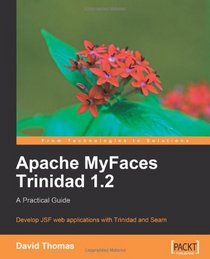Search -
Apache MyFaces Trinidad 1.2: A Practical Guide
Apache MyFaces Trinidad 12 A Practical Guide
Author:
Develop JSF web applications with Trinidad and Seam
This book introduces Apache MyFaces Trinidad, a powerful JSF component framework and combines it with Seam, the next-generation Web Application Framework to achieve the most comprehensive and effective technology for the development of powerful rich-client web applications.
In this book, you start out by learning where Trinidad comes from and what its aims are. You will learn how Facelets and Seam are used to get the most out of JSF. In addition, you will also learn the often occurring tag attributes, and, in particular, Trinidad's AJAX technology. You will implement login, authorization, navigation, internationalization, polling, and support for browser issues with the help of these technologies. You will then use Seam-gen for deployment.
Next, you will develop a web application example where a series of selected Trinidad components are applied and their capabilities explored. Finally, you will master the Trinidad dialog framework, a key Trinidad technology that allows the application of dialogs. What you will learn from this book?
Author:
Develop JSF web applications with Trinidad and Seam
- Develop rich client web applications using the most powerful integration of modern web technologies
- Covers working with Seam security, internationalization using Seam, and more
- Get well-versed in developing key areas of web applications
- A step-by-step approach t... more »
This book introduces Apache MyFaces Trinidad, a powerful JSF component framework and combines it with Seam, the next-generation Web Application Framework to achieve the most comprehensive and effective technology for the development of powerful rich-client web applications.
In this book, you start out by learning where Trinidad comes from and what its aims are. You will learn how Facelets and Seam are used to get the most out of JSF. In addition, you will also learn the often occurring tag attributes, and, in particular, Trinidad's AJAX technology. You will implement login, authorization, navigation, internationalization, polling, and support for browser issues with the help of these technologies. You will then use Seam-gen for deployment.
Next, you will develop a web application example where a series of selected Trinidad components are applied and their capabilities explored. Finally, you will master the Trinidad dialog framework, a key Trinidad technology that allows the application of dialogs. What you will learn from this book?
- Integrate Trinidad with Facelets and Seam to get the most out of JSF
- Tackle web application issues with the help of Seam
- Create a panel-based Trinidad user interface using Trinidad forms and Facelet input components
- Create a wizard based on Trinidad components
- Create pop-up or main browser window dialogs using Trinidad dialog framework
- Work with Trinidad's table technology features including the use of JSF binding
- Get a grip on Trinidad's AJAX technology, or more adequately described, its partial page rendering technique (PPR)
- Deploy your web applications using Seam-gen
- Implement login, authorization, navigation, internationalization, and more
- Master all the major concepts of Trinidad
ISBN-13: 9781847196088
ISBN-10: 184719608X
Publication Date: 11/10/2009
Pages: 292
Rating: ?
ISBN-10: 184719608X
Publication Date: 11/10/2009
Pages: 292
Rating: ?
0 stars, based on 0 rating
Genres:
- Computers & Technology >> Programming >> Graphics & Multimedia >> General
- Computers & Technology >> General




